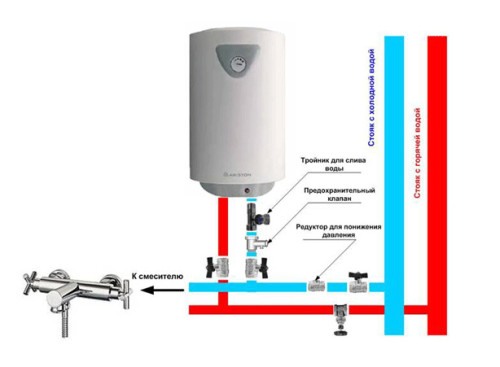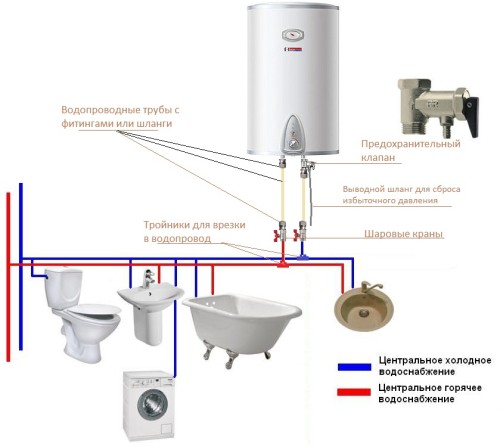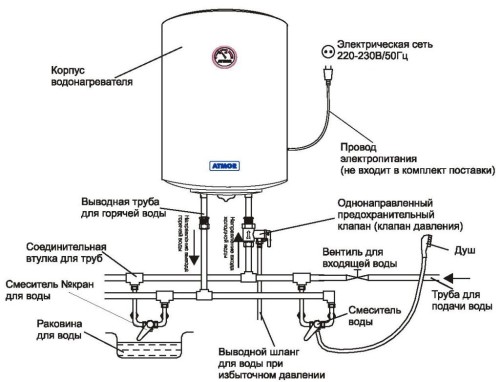The main purpose of the boiler is to provide residential and public premises with hot water. For many, this equipment is the only solution to provide your house with hot water, especially if it is outside the city. There are running and cumulative boilers on sale. In the first of them, water heating occurs without its accumulation. The second type of devices heats water with accumulation, which allows you to get a large volume of hot water immediately.
Content
- Instructions for the installation of the boiler: General recommendations
- Installation of a prototype type boiler
- Installation of the accumulative type boiler
- Errors during installation and installation of a boiler
- Features of the installation of the boiler and the connection diagram in a private house
- Installation of a gas boiler
- DIY Boiler Installation: Video
Instructions for the installation of the boiler: General recommendations
Installation of water heaters of various types is best performed by observing some rules. Moreover, different types of boilers have differences in the installation process. For example, the installation of an indirect boiler will be carried out according to a different scheme than installing a storage device. Based on this, the process of installing various types of boilers should be considered separately.
DIY boiler installation has its advantages and disadvantages.
In particular, the following should be attributed to the "strengths" of independent installation:
- Saving time and money.
- In addition, you will acquire useful skills that will become indispensable when servicing or repairing a water heater. If you need the repair of the unit, then you will not have to call the master. After all, you, most likely, with the help of the skills you can dismantle equipment for repairing your own hand.
The disadvantages of independent installation should be attributed, first of all, a large risk of flooding of neighbors, especially if you have no experience in this matter.
Before starting installation, you need to not only choose the type and model of the boiler, but also decide on several important points:
- In particular, free access to the device during its operation should be provided.
- It is also important that the wall on which it is planned to mount the unit has a double margin of safety, i.e. When installing a boiler for 150 liters, it should withstand the load of at least 300 kg.
- It is important to analyze the condition of risers and pipes, determine the presence of outputs for connecting the device. Sometimes you have to replace the entire water supply in the apartment.
- If the wiring is old in the apartment, then it is best to invite a specialist who will help to determine her condition. In addition, he will tell you whether the wiring can withstand the required load. If necessary, it will need to be replaced. You can choose a cross section of the electric cable for the selected equipment using a special table.
Installation of a prototype type boiler
When installing this type of boiler, first of all, you need to check the voltage in the mains - it must correspond to the data provided for in the instructions. So that the device works without failures, at the entrance the water temperature should be no more than 30 degrees. The unit is fixed in any convenient place and only after that water pipes join it.
There are several options for the location of the boiler. Most often, this equipment is placed under or above the sink. The boiler and water intake valves must be connected by nozzles. This should be done before the equipment will be installed in its place. The pipes are fixed using overhead nuts with a seal. When they are recorded, the system must be checked for tightness. To do this, you should serve water and determine the presence of leaks.
If it was decided to hang a water heater above the sink, then, first of all, the boiler itself should be fixed in its place. Only after that, pressure reinforcement is installed on the sink by connecting the tee to the valve with cold water. Similarly, connecting nozzles are connected to the tee. After completing the installation process, the unit can be brought to the network. For each phase of the mains, the installation of replaceable fuses or an introductory circuit breaker should be provided. It is important that at the same time there is a distance of at least 4 mm between the wires. This is necessary so that the water heater can be de -energized.
Installation of the accumulative type boiler
When all the necessary preparatory work will be carried out, you need to make holes for anchors. The hooks of questionnaires to the wall should be attached at a distance from the surface of 30-45 cm. For the convenience of servicing the water heater during its operation, the distance from the cover to the nearest wall should be at least 30-50 mm. The larger the volume of the boiler, the more this distance should be.
To reduce heat loss, it is recommended to mount the water heater as close as possible to the place where hot water is most often needed. Before hanging the unit, you need to make sure that there are anchor hooks fixed in the wall. In the case of the device for attaching to these hooks there are special fasteners. When installing a boiler, it is necessary to take into account the features of its design. The existing pipes should be located as indicated in the instructions for the selected model.
The input hole of the boiler is quite easy to distinguish - it is usually marked with a blue ring. The safety valve is first mounted on it. To ensure the tightness of the connection, the insulation should be used. For example, a fum tone. The installation of the safety valve should be taken with special attention. Indeed, without it, the use of a water heater is prohibited by the manufacturer himself. The same goes for installing a valve of another brand.
To connect the boiler, it is best to use only high -quality modern pipes. When the unit is connected to the water supply, you can open water. At the same time, you need to open hot water on the mixer so that the air can get out of the installed equipment. Then you can turn on the water heater. To do this, you just need to turn on the device in the outlet and put the temperature controller on a value of more than 40 degrees. Before that, it should be checked that the tank is filled with water.
Errors during installation and installation of a boiler
The installation of the boiler will be more successful if you know in advance about what you cannot allow during work:
- In no case do not turn on the equipment if there is no water in the container.
- You must not allow the replacement of components with parts of another model and manufacturer. Use only those that are included in the delivery of the selected boiler.
- When connecting the unit to the mains, a protective casing or cover should not be removed. You can drain water from the boiler only after the equipment is disconnected.
- In addition, the water heater cannot be used if grounding is not done for him.
- You can turn on the boiler only with normal pressure in the water supply. If it is too weak or, conversely, very strong, then the equipment cannot be turned on.
Features of the installation of the boiler and the connection diagram in a private house
In private houses, such devices are used more often than in city apartments. To date, water heaters in a private house can be connected according to four schemes, each of which should be considered in more detail. One of these connections is a connection through a three -way channel. It is usually used for wall units. It works as follows: under certain conditions, a thermostat is triggered, which shifts the valve, which, in turn, triggers water circulation through the serpentine heater. This happens until the water temperature reaches a certain value. When this happens, the valve is overlapping so that the water stops the circulation. To operate the system with such a connection, there should be a circulation pump and an expansion tank.
Another type of connection involves the use of two pumps. In this case, the heating operation is one -sided. To heat the water, the circulation system of the heating circuit circulation is disconnected. Thanks to this, water begins to move in the drive. When the water is heated to the desired temperature, its circulation resumes and the heating stops. Due to the features of the operation of such a connection, the room is not heated constantly due to the fact that you should sometimes turn off the system.
Another connection option uses several contours. This is relevant when several boilers are used to heat the construction at the same time. The operation of such a system is regulated by valves.
There is also a connection through a hydraulic collector. This method is relevant if the boiler is used both for the warm floor and for the main heating at the same time. The same option is suitable for water heaters connected to a hydraulic collector, which use a gas boiler to heat water.
Installation of a gas boiler
Phased installation procedure:
- Initially, at the installation site, marking of holes for the dowel is made. After drilling, hooks are clogged in them.
- Next, a gas column is hung on the mount in the wall. Then, corrugation is installed from the chimney to remove carbon monoxide. One end of it should enter the existing chimney tightly, and the other is dressed on the output of the column.
- Next, you will need a rubber hose, through which the gas pipe is connected to the device.
- Now it is necessary to prepare a soap solution that needs to lubricate all the compounds properly. If small bubbles appear at the junction, then you need to take the key and squeeze the nut of the hose connection. If this cannot be eliminated by gas omissions, it is better to call a specialist.
- The next step is the water supply through hoses or PVC pipe. The connection process is almost the same as when connecting an electric unit. The assembly procedure is as follows: pipes, a crane and, finally, the connection of the unit with a hose. The input of the cold and the output of hot water on most boilers is indicated equally - input in red.
- Then the system must be checked for tightness. To do this, just open the taps and inspect the connections. The discovered leaks must be eliminated. Gently fix the nut in the right place or use the pac from the right place.
- After eliminating the leak, you can install a power source and open the hot water crane. The unit must start heating itself. Moreover, warm water should go in a few seconds. Water temperature regulation is carried out in each boilers in different ways.















